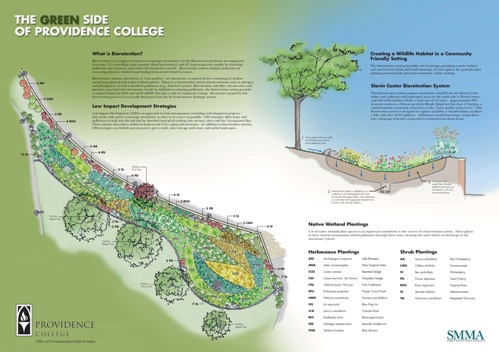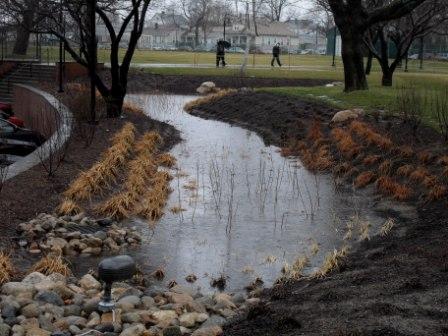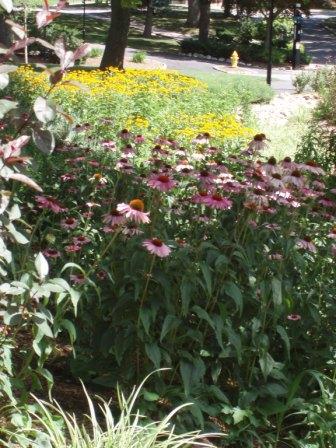Bioretention System
Slavin Center Bioretention System
The Slavin Center bioretention system captures stormwater runoff from the Slavin Center lobby roof, walkways and landscaped areas on the south side of Slavin Center, and half of Hendricken Field — a total area of 3.5 acres.
Approximately 90% of storm events in a 24-hour period in Rhode Island are less than 1.2 inches; a rainfall amount commonly referred to as the “water quality storm event.” This bioretention system is designed to capture and filter a run-off volume of about 1,240 cubic feet (9,275 gallons). Additional run-off from larger storms flows into a drainage structure connected to a downstream storm drain.

What is Bioretention?
Bioretention is an engineered process to manage stormwater run-off. Bioretention performs two important functions: (1) controlling water quantity (flood prevention); and (2) improving water quality by removing pollutants and nutrients associated with stormwater run-off. Bioretention systems mitigate pollutants by recreating physical, chemical and biological processes found in nature. Bioretention systems, also known as “rain gardens,” are stormwater treatment devices consisting of shallow excavations planted with native wetland species. Plants in a bioretention system absorb nutrients such as nitrogen and phosphorus, as well as dissolved pollutants (e.g., dissolved metals). Bioretention soils filter out microbes and particles associated with stormwater runoff. In addition to removing pollutants, the bioretention system provides a natural habitat for birds and small wildlife that play a role in a balanced ecology. Stormwater treated by this bioretention process is eventually discharges to the local stormwater drainage system.
Low Impact Development Strategies
Low Impact Development (LID) is an approach to land management, including redevelopment projects, that works with nature to manage stormwater as close to its source as possible. LID strategies allow water and pollutants to soak into the soil and be absorbed instead of washing into streams, rivers and the Narragansett Bay. These systems also reduce sediment loads on the City’s aging infrastructure. In addition to bioretention systems, LID strategies can include porous pavers, green roofs, water storage and reuse, and native landscapes.
Native Wetland Plantings
Use of native wetland plant species is an important contributor to the success of a bioretention system. These plants in their natural environment absorb pollutants through their roots, cleaning the water before its discharge to the stormwater system.
Creating a Wildlife Habitat in a Community Friendly Setting
The bioretention setting beautifies the landscape providing a native habitat and sanctuary for birds and small mammals. As you explore the grounds enjoy sighting seasonal birds and native mammals’ winter nesting.







